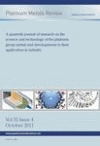-
oa The Role of Palladium in Enhancing Corrosion Resistance of Titanium
- Source: Platinum Metals Review, Volume 11, Issue 2, Apr 1967, p. 50 - 52
-
- 01 Jan 1967
Abstract
It is well known that the addition of about 0.2 per cent palladium to titanium significantly increases its resistance to corrosion in non-oxidising acids. It has usually been assumed that the palladium is present as elemental particles at the metal surface and that these function electrochemically to provide anodic passivation of the titanium matrix. It has, however, now been demonstrated that even in low concentration palladium additions to titanium form Ti2Pd, and that before onset of passivation the palladium dissolves in the corrodent and is then reprecipitated in elemental form from solution. This process is accompanied by the growth of a protective film of TiO2. In substantiation of this mechanism it can be shown that corrosion of unalloyed titanium in non-oxidising acids can be halted by the addition to the acid of a very small quantity of a soluble palladium salt.


